Archived article
Please note that tax, investment, pension and ISA rules can change and the information and any views contained in this article may now be inaccurate.

Perhaps, thanks to AI, investors need to consider the words of American industrialist J. Paul Getty, who once asserted, ‘In times of rapid change, experience can be your worst enemy,’ because those who are sticking to long-held valuation disciplines are getting left behind as US equities generally, AI-related names more specifically and cryptocurrencies are all on a roll.
Once markets start rolling, they can run for a long time, especially when their preferred narrative continues to play out, as it is right now, in the shape of cooling inflation, steady economic growth and falling interest rates.
Valuation only really matters when a catalyst appears to change perception and persuade investors an asset class or individual security is too dear or too cheap, so investors need to be on the look-out for changes that might alter the narrative, in the form of either hotter inflation, faster or slower growth, or interest rates that stay higher for longer (or even start to rise again).
Five themes in particular could have a major say on all fronts in 2025 and beyond.
1. Sovereign debt
The new Labour government in the UK still taking brickbats as it seeks to address Britain’s fiscal deficit, a French administration is in tatters after just three months as its efforts to raise taxes and cut spending get the thumbs down and, all the while, America’s federal debt continues to mushroom. President-elect Trump’s policy package could even accelerate growth in government borrowing from what is already a record-high of $36 trillion.
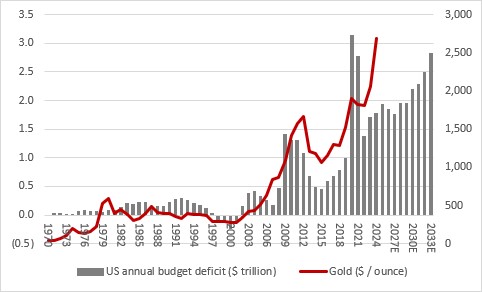
Source: FRED - St. Louis Federal Reserve database, Congressional Budget Office, LSEG Refinitiv data
America’s annualised interest bill on that debt already exceeds $1 trillion, a sum larger than the defence budget. There could be trouble ahead, unless Elon Musk and Vivek Ramaswamy really do cut spending in the new department of government efficiency, or Trump’s tariffs raise income and boost domestic output. Either bond yields rise in the face of growing supply, or interest rates stay higher for longer, or the Fed looks to cut rates and take a chance with inflation to lower the interest bill (contrary to the prevailing narrative of cooler inflation). This final scenario may be why gold (and bitcoin, for that matter) are on a roll, as investors seek perceived stores of value.
2. World trade flows look strong – for now
Trump talked loudly and carried a big stick on the subject of tariffs during his first term, but he only really wielded the stick at China. Other nations, such as France and Mexico, were spared, albeit only once they offered concessions. We may see the same again this time around given Trump’s propensity to seek a deal.
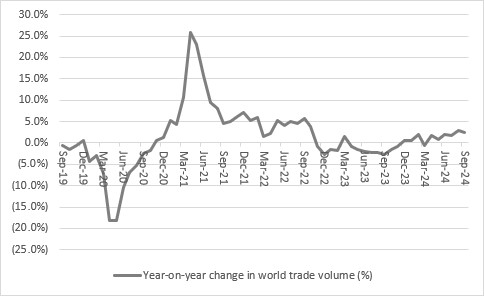
Source: CPB World Trade Monitor
If all of the planned tariffs are imposed, it seems logical to assume this will boost inflation, as the price of imported goods will rise owing to the duties, or the higher cost of domestic production.
But the best cure for higher prices is higher prices, as they ultimately curtail demand (or stoke output), and tariffs are seen as a major contributor to the deep global downturn suffered in the 1930s, so the picture may not be so simple. Markets still think growth is set fair in 2025, and tracking world trade flows will help to gauge whether that is the case or not. At the moment, the picture looks healthy.
3. Watch the dollar
If Trump’s tariffs succeed in reducing America’s trade deficit, that will mean fewer dollars leave America. If they produce America’s first trade surplus since 1975, dollars will actively flow back into the US. That could be a problem, according to Robert Triffin’s theories, because of the dollar’s status as the world’s reserve currency. In essence, greenbacks are the grease that oils the global economy and financial markets and without them global liquidity could dry up quickly, with potentially deleterious consequences.
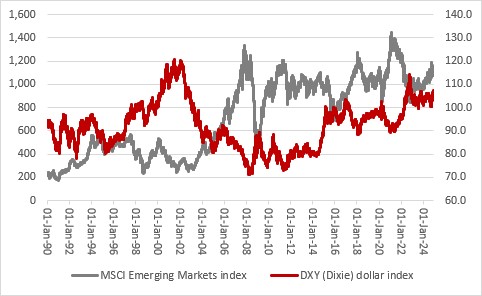
Source: LSEG Refinitiv data
Emerging markets are traditionally very sensitive to the dollar, as many developing nations tend to borrow in bucks, and a strong US currency increases the cost of servicing that debt to the detriment of growth and investment. Investors here will therefore be watching US trade policies with particular care.
4. Oil and food prices could yet shape inflation
Inflation continues to hover around the 2% target given to central bankers around the world, thanks to a marked easing in goods prices. Food and oil prices are helping here, but they remain highly unpredictable, thanks to the vagaries of the weather and geopolitics. It could be worth tracking both in 2025, especially as services inflation remains elevated and that could in turn stoke wage demands.
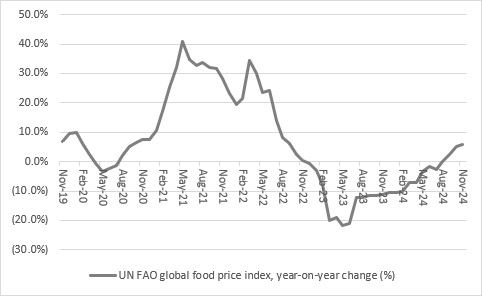
Source: United National Food and Agriculture Organization
5. Investors keep riding the Magnificent Seven
The scientist and science fiction writer Arthur C. Clarke asserted that, ‘Any sufficiently advanced technology is indistinguishable from magic,’ and investors seem as bedazzled as ever by the so-called Magnificent Seven of Alphabet, Amazon, Apple, Meta, Microsoft, Nvidia and Tesla.
This year’s average 65% gain across the septet leaves them with an aggregate market capitalisation of $18 trillion, or 35% of the S&P 500. That powerful performance in turn means the S&P 500 represents 63% of the FTSE All-World’s market valuation, a level that exceeds even the high seen at the peak of the technology, media and telecoms bubble in 2000.
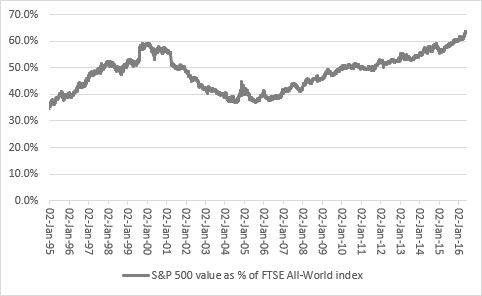
Source: LSEG Refinitiv data
The share price and profit wobbles of 2022 showed that the Magnificent Seven are not entirely immune to the economic cycle, so an unexpected recession could be one challenge. Sustained inflation could be another if it keeps rates higher than expected and boosts nominal growth from downtrodden cyclicals and value stocks. Again, only a perfect middle path may do to justify their lofty valuations, let alone sustained further upside.
Ways to help you invest your money
Put your money to work with our range of investment accounts. Choose from ISAs, pensions, and more.
Let us give you a hand choosing investments. From managed funds to favourite picks, we’re here to help.
Our investment experts share their knowledge on how to keep your money working hard.
Related content
- Fri, 02/05/2025 - 11:37
- Thu, 01/05/2025 - 16:33
- Thu, 01/05/2025 - 09:45
- Tue, 29/04/2025 - 11:41
- Fri, 25/04/2025 - 14:52

